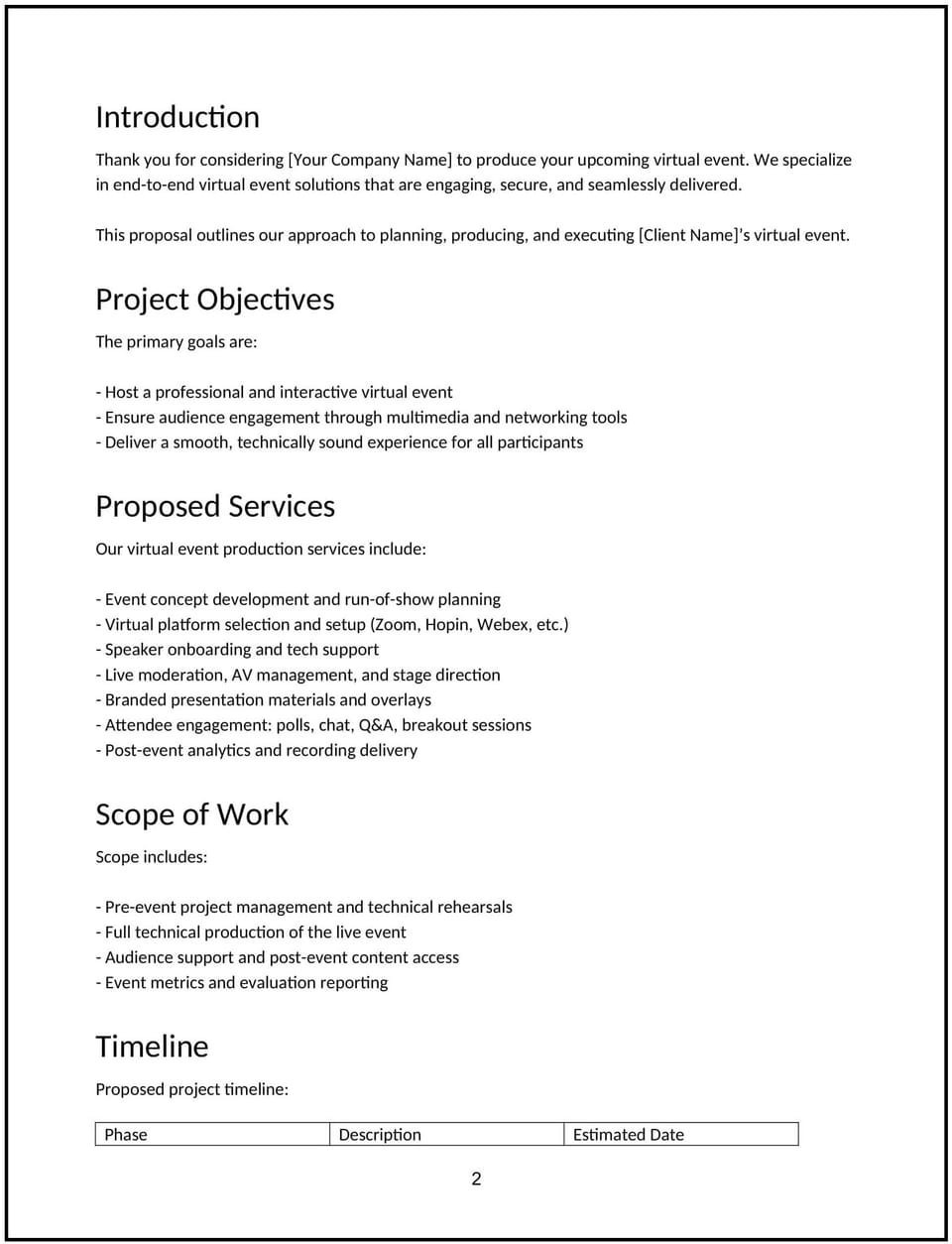Virtual event proposal: Free template

Customize this free virtual event proposal with Cobrief
Open this free virtual event proposal in Cobrief and start editing it instantly using AI. You can adjust the tone, structure, and content based on your offer, the client’s event goals, and the audience size or format. You can also use AI to review your draft — identify missing details, tighten sections, and make your proposal more persuasive.
Once you're done, send, download, or save the proposal in one click — no formatting or setup required.
This template is fully customizable and built for real-world use — ideal for hosting virtual conferences, summits, team-building sessions, or product launches. Whether you’re managing tech, content, or logistics, this proposal gives you a structured foundation to close the deal faster.
What is a virtual event proposal?
A virtual event proposal outlines how you’ll plan, produce, and manage an online event. It typically includes your scope of services, event platform, timeline, pricing, and next steps — and is shared after a discovery call or client inquiry.
This proposal is used by event planners, producers, marketing teams, and agencies across industries. Whether the event is internal or public-facing, one-off or recurring, this proposal helps set clear expectations and showcase your process.
Compared to traditional event proposals, this version focuses on digital execution — including webinar tools, engagement tactics, speaker logistics, and live production needs.
Why use Cobrief to edit your proposal
- Edit the full proposal instantly: No uploading, copying, or formatting required.
- Use AI to rewrite and tailor each section: Match tone, audience, and industry with ease.
- Run a full AI-powered review: Spot missing scope details, vague language, or formatting issues.
- Apply changes in one click: Accept individual edits or apply all suggestions at once.
- Save, send, or download: Export your polished proposal instantly — all in-browser.
When to use this proposal
- When proposing a live virtual summit, panel, or multi-session event
- When responding to an inquiry from a brand or organization about remote event support
- When following up after a planning call to outline the timeline, scope, and pricing
- When offering technical and creative production for livestreamed events
- When bundling content development, speaker coordination, and virtual logistics into one service
What to include in a virtual event proposal
- Project overview: Summarize the event type, goals, and audience. Mention whether it's internal or external, the expected format, and your role in helping deliver a successful experience.
- Scope of work: List the services you’ll provide — platform setup, tech run-throughs, agenda management, speaker support, live moderation, recording, editing, and attendee support. Be clear about what's included and what’s not.
- Timeline: Break down the full schedule — from onboarding and content prep to tech checks, event day, and post-event wrap-up. Include all key milestones and deadlines.
- Platform and tech tools: Detail the event platform (e.g., Zoom, Hopin, Microsoft Teams) and any third-party tools used for engagement, analytics, or backup support.
- Pricing: Provide a clear pricing structure — fixed fee, hourly rate, or package options. Include what’s covered in your fee and any add-on services priced separately.
- Call to action / next steps: End with a clear prompt, like scheduling a kickoff call, confirming the date, or approving the proposal. Make it simple for the client to move forward.
How to write an effective virtual event proposal
- Speak to outcomes: Emphasize results like engagement, seamless delivery, and audience satisfaction — not just tasks.
- Highlight platform fluency: Show that you understand the client’s preferred tools or can recommend the best-fit solution.
- Demonstrate organization: Clients want to feel like the entire experience is under control — from tech to timing.
- Personalize based on event type: Whether it’s a product launch or internal town hall, tailor the proposal to the use case.
- Keep it clear and skimmable: Use headers, short paragraphs, and bullet points to aid readability.
- End with confidence: Always close with a clear next step and a sense of momentum.
Frequently asked questions (FAQs)
Can I use this proposal for hybrid events with a virtual component?
Yes — you can edit the scope and timeline sections to reflect any on-site support or live streaming from a physical venue.
What kinds of virtual events is this template best suited for?
It works well for conferences, webinars, summits, internal meetings, training sessions, product demos, and more.
Can I add my own branding or media?
Yes — you can customize the content, upload branded assets, or link to example videos and past events.
Can I adjust the pricing for recurring or multi-event clients?
Absolutely. You can edit the pricing section to reflect retainer packages or volume-based discounts.
Does this proposal include a contract?
No — this is a proposal, not a legal agreement. For contracts or terms, you should send a separate document after approval.
This article contains general legal information and does not contain legal advice. Cobrief is not a law firm or a substitute for an attorney or law firm. The law is complex and changes often. For legal advice, please ask a lawyer.